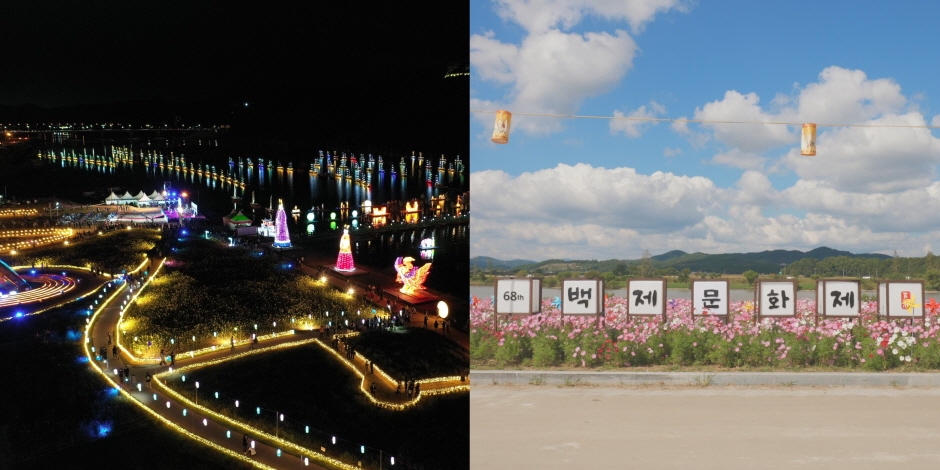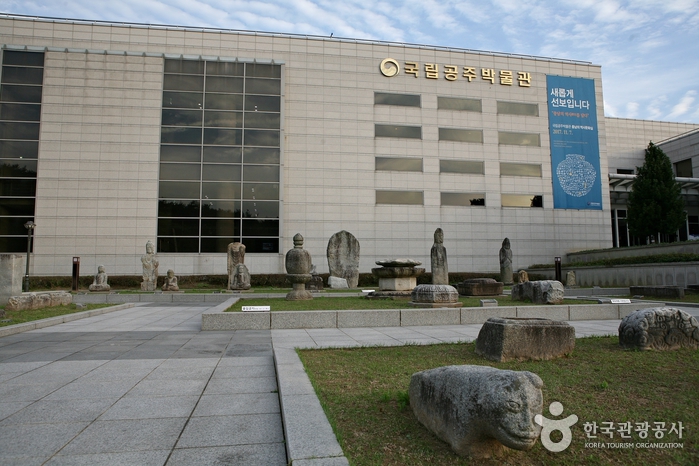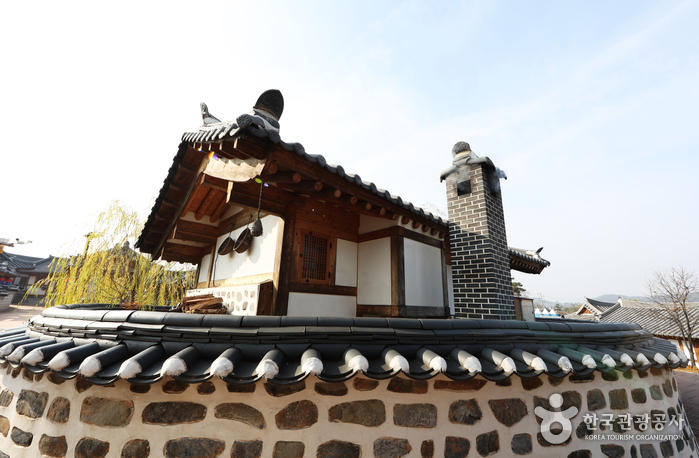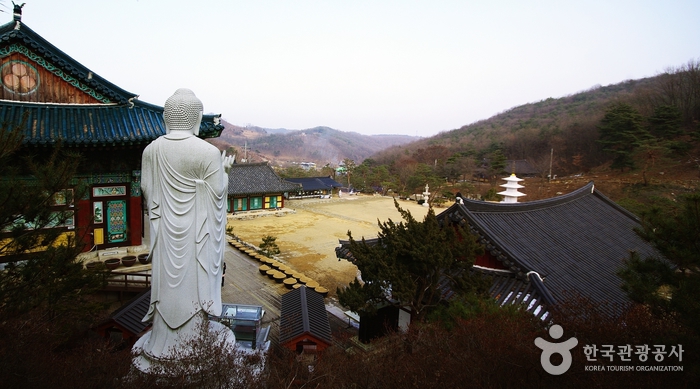Guard-Changing Ceremony of Woongjinseong Fortress (웅진성수문병 근무교대식)
11.5Km 2022-12-21
280, Woongjin-ro, Gongju-si, Chungcheongnam-do
• 1330 Travel Hotline: +82-2-1330 (Korean, English, Japanese, Chinese) • For more info: +82-41-856-7700
The Guard-Changing Ceremony of Woongjinseong Fortress takes place at Gongsanseong Fortress, a part of the Baekje Historic Areas which is a desginated UNESCO's World Heritage Site. The ceremony reenacts the service of the guards defending the castle, using costumes and props based on the strict analysis of the historical records. The ceremony is held every Saturday and Sunday from April to November except during hot summer season of June to August, and conducted every day during the Baekje Culture Festival in the fall. The event includes martial art performances and various experiences as well as the main ceremony, aiming at promoting Gongju-si, where the Baekje culture flourished, and its valuable heritage Gongsanseong Fortress.
Gongju Tomb of King Muryeong and Royal Tombs [UNESCO World Heritage] (공주 송산리 고분군과 무령왕릉 [유네스코 세계문화유산])
11.6Km 2024-01-08
37-2 Wangreung-ro, Gongju-si, Chungcheongnam-do
The Songsan-ri Tombs and Royal Tomb of King Muryeong (r. 462-523) contain representative relics of the Baekje period (234-678). The Songsan-ri Tombs contain the graves of kings from the period when Baekje's capital was Gongju, and it is believed to contain 17 such graves. Only seven graves have been discovered so far. There are two types of tomb designs: traditional Baekje-style rock and earth fortification tomb and Chinese-influenced rock tomb. The tombs number one to five were made using the traditional Baekje-style design while tomb number six and the Royal Tomb of King Muryeong were made using the Chinese-influenced design. Even though many artifacts were stolen from the tombs, the tombs serve as an important evidence of Baekje culture and the foreign exchanges from during that period.
HONG WHI KWAN[Korea Quality] / 홍휘관[한국관광 품질인증/Korea Quality]
11.6Km 2020-11-19
6-6, Baengmigoeul-gil, Gongju-si, Chungcheongnam-do
+82-10-9701-3141, +82-41-858-8890
Located in Gongju, South Chungcheong Province, Hongwhikwan offers guests a traditional “hanok” experience filled with the gentle scents of red clay and wood. The hotel is located in front of the UNESCO World Heritage site Gongsanseong Fortress, with Geumgang River flowing behind the complex.
There are six rooms in total, all Korean-style with floor bedding for double, triple, and quadruple occupancy. High ceilings and exposed girders greet visitors upon entering the rooms that are decorated with traditional bedding, Korean paper windows, elegant muslin curtains, and colorful cushions. Each room is equipped with a TV set, a refrigerator, and a bathroom with a hairdryer, making it an ideal place to start and end the day. The spacious courtyard also comes with traditional games like “jegi chagi” and “yutnori.” Coffee and Korean tea are found in the second-floor community room, while the kitchen serves complimentary breakfast every morning with a simple menu of toast, beverages, fruits, and breakfast cereals. Furthermore, the complex is close to major tourist sites, such as the Gongjusanseong Market, Gongju National Museum, the UNESCO World Heritage site Ancient Tombs in Songsan-ri, and Tomb of King Muryeong. Hongwhikwan also offers free bicycle rentals for guests to stroll around the location.
Baekje Experience Center (백제오감체험관)
11.8Km 2024-01-08
30 Gomanaru-gil, Gongju-si, Chungcheongnam-do
The Baekje Experience Center offers a rich array of activities that allow visitors to engage with the history they have observed at the nearby ancient tombs in Songsan-ri and the Gongju National Museum in a tactile manner. This center features eight themed halls across the first basement, and the first and second above-ground floors, offering interactive and gaming programs designed to stimulate all five senses. Activities such as rubbing pattern experience and luminous stamps allow visitors to learn about and appreciate the culture and history of Woongjin Baekje in an intuitive way. One of the center’s highlights is the Window of Sympathy in the first-floor lobby. This impressive two-story panel changes its color in response to sound and touch, promising to attract significant attention from tech-savvy visitors. It showcases content that guests have captured within the center and shared on social media, complete with hashtags. Additionally, the Window of Creation on the same floor offers a unique creative outlet. Here, visitors can color Baekje-era relics with crayons. These artworks are then transformed into graphic mapping images on the wall via a scanner, allowing for a personalized and immersive historical experience.
Baekje Cultural Festival (백제문화제 )
11.9Km 2024-07-17
368 Geumbyeok-ro, Gongju-si, Chungcheongnam-do
Gongju: +82-41-840-8090 Buyeo: +82-41-830-2208
Baekje Cultural Festival first started in 1955 and aims to bring the history and culture of the Baekje era to life, taking place at UNESCO-recognized sites throughout Gongju and Buyeo.
Mireuseom Island (미르섬)
11.9Km 2023-10-27
368 Geumbyeok-ro, Gongju-si, Chungcheongnam-do
Mireuseom Island is covered in a blanket of beautiful plants every fall, from cosmos to pink muhly, broom cypress and pearl millet. The pink muhly growing along the Geumgang River is a popular photo spot. The beautiful landscape unfolds the longer you walk towards Gongjudaegyo Bridge.
Himart - Gongju Branch [Tax Refund Shop] (하이마트 공주점)
11.9Km 2024-04-18
51, Beonyeong 1-ro, Gongju-si, Chungcheongnam-do
-
Gongju National Museum (국립공주박물관)
12.0Km 2021-05-20
34, Gwangwangdanji-gil, Gongju-si, Chungcheongnam-do
+82-41-850-6300
Gongju National Museum preserves and displays cultural treasures, as well as provides educational programs for locals. The museum collection includes over 10,000 relics, including 19 National Treasures and three Treasures, all excavated from the Chungcheongnam-do & Daejeon areas. The most important of these artifacts are displayed permanently, while the remaining items rotate with special exhibitions. In front of the main building is a garden visitors can enjoy after touring the museum.
Gongju Hanok Village (공주한옥마을)
12.1Km 2024-12-23
12 , Gwangwangdanji-gil, Gongju-si, Chungcheongnam-do
+82-41-881-2828
Gongju Hanok Village is in Gongju, Chungcheonnam-do, midway between the Songsan Ancient Tombs - burial place of King Muryeong of Baekje and his queen - and Gongju National Museum. The hanok are ondol-heated and have a card key security system. The village offers both individual and group accommodation, each in a different building; in the group buiding each room has a separate locker room and shower. Baekje history and culture programs on offer include a Baekje costumes experience, a royal tea ceremony, royal candies and Baekje relics.
Yeongpyeongsa Temple (영평사)
12.1Km 2021-11-01
124, Yeongpyeongsa-gil, Sejong-si
+82-44-857-1854
A branch of Magoksa Temple, which is the 6th local temple of the Jogyejong Order, Yeongpyeongsa Temple has six traditional buildings and three small hermitages. Janggunsan Mountain, where the temple is located, is small but full of energy. According to Feng Shui, the mountain is a perfect location for a temple because it is shaped like a dragon curled along the Geumgang River. Yeongpyeongsa is a tranquil place that captures the purity of the temple’s Buddhist practice, with fresh air and clean water that offer a habitat for fireflies, crawfish, and black snails. On the way in, visitors are greeted by a multitude of wildflowers vying for their attention: the columbines and the prairie crocuses in spring, the white lotuses in summer, and the Siberian chrysanthemums in autumn.

![Gongju Tomb of King Muryeong and Royal Tombs [UNESCO World Heritage] (공주 송산리 고분군과 무령왕릉 [유네스코 세계문화유산])](http://tong.visitkorea.or.kr/cms/resource/95/2678695_image2_1.jpg)
![HONG WHI KWAN[Korea Quality] / 홍휘관[한국관광 품질인증/Korea Quality]](http://tong.visitkorea.or.kr/cms/resource/57/2651357_image2_1.jpg)

![Himart - Gongju Branch [Tax Refund Shop] (하이마트 공주점)](http://tong.visitkorea.or.kr/cms/resource/43/2883343_image2_1.jpg)



 English
English
 한국어
한국어 日本語
日本語 中文(简体)
中文(简体) Deutsch
Deutsch Français
Français Español
Español Русский
Русский